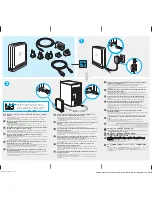
Frame Relay Transmission
26
Avidia System Configuration and Management User Manual
The following illustration shows an example of a configured PVC, including the specific VPI
and VCI values associated with each segment of the connection.
ATM PVCs can also be set up to run bridging, routing or brouting sessions. See
Bridging and Routing Sessions” on page 228
Bridging and Routing Sessions” on page 486
(Web interface) for information about setting up
and running bridging, routing, and brouting sessions over ATM PVCs.
F
RAME
R
ELAY
T
RANSMISSION
Frame relay interworking allows frames to be transported by an ATM network to an ATM
device or another frame relay device. Use frame relay with the IDSL frame-based card that
attaches to modems using frame relay protocol. There are two standards for interworking:
•
FRF.5 defines how frames are encapsulated so that they can be carried by the ATM network
to another frame device.
•
FRF.8 defines how frames are translated between ATM and frame devices.
To set up frame relay services:
•
Configure service for each IDSL frame card port (includes selecting the IDSL card transmit
clock source, and the IDSL line profile and IDSL alarm profile for each port).
•
Configure the frame relay link for each port, which involves setting the LMI (Local
Management Interface) parameters. The LMI type defines the method of exchanging status
information between the customer device and the network. The available LMI types are
LMI Rev-1, ITU 0.933 Annex-A, ANSI T1 617 Annex-D, and no LMI support.
Cross-connect
PVC
VPI-0
VCI-100
VPI-250
VCI-300
VPI-250
VCI-300
VPI-0
VCI-100
OC3
card
ATM
Network
Access
Provider
Cell-Based ADSL
Channel Card
Network-side VPI/VCI values
are obtained from ATM
network access provider
Subscriber VPI/VCI values
are obtained from
ADSL access provider
Ports are mapped
to same VPI/VCI
VPI/VCI is mapped
to continue to next
network segment
Ports are mapped
to same VPI/VCI
Megabit Modem
700F
600F
500L
Summary of Contents for AVIDIA SWD4573I1
Page 6: ...Summary of Changes for Version 2 0 vi Avidia System Configuration and Management User Manual...
Page 26: ...Table of Contents xxvi Avidia System Configuration and Management User Manual...
Page 28: ...2 Avidia System Configuration and Management User Manual...
Page 36: ...Management Tools and Protocols 10 Avidia System Configuration and Management User Manual...
Page 44: ...Next Steps 18 Avidia System Configuration and Management User Manual...
Page 102: ...Saving Configurations 76 Avidia System Configuration and Management User Manual...
Page 104: ...78 Avidia System Configuration and Management User Manual...
Page 166: ...Configuring xDSL Subscriber Names 140 Avidia System Configuration and Management User Manual...
Page 230: ...Configuring ATM Policing 204 Avidia System Configuration and Management User Manual...
Page 302: ...Monitoring IDSL Current Performance 276 Avidia System Configuration and Management User Manual...
Page 396: ...370 Avidia System Configuration and Management User Manual...
Page 438: ...Configuring IDSL Service 412 Avidia System Configuration and Management User Manual...
Page 440: ...Configuring IDSL Service 414 Avidia System Configuration and Management User Manual...
Page 452: ...Configuring DS3 Service 426 Avidia System Configuration and Management User Manual...
Page 492: ...Configuring ATM Policing 466 Avidia System Configuration and Management User Manual...
Page 582: ...Monitoring IDSL Alarm Status 556 Avidia System Configuration and Management User Manual...
Page 618: ...Activating and Deactivating Ports 592 Avidia System Configuration and Management User Manual...
Page 620: ...594 Avidia System Configuration and Management User Manual...
Page 628: ...Setting the System Date and Time 602 Avidia System Configuration and Management User Manual...
Page 636: ...610 Avidia System Configuration and Management User Manual...
Page 642: ...Glossary 616 Avidia System Configuration and Management User Manual...
Page 657: ......
















































